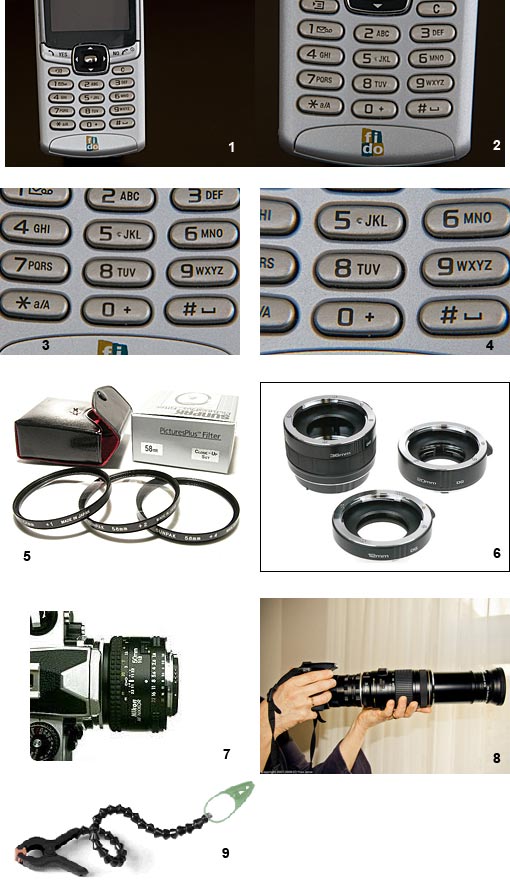Photography podcast #37 focuses on cheap macro photography setups. In this podcast we talk about using reversing rings, extension tubes, close-up lenses and cheap macro lenses in order to achieve good macro results for little cash.‚Special thanks to ‚Yves Janse who suggested this podcast.
The following images describe the different inexpensive techniques used to create macro photographs

1 — Shows my shot with a zoom lens only
2 — Shows shot with cheap close-up lens #1
3 — Shows shot with cheap close-up lens #2
4 — Shows shot with cheap close-up lens #4
5 — Shows what close-up lenses look like
6 — Shows what extension tubes look like
7 -‚Shows what a lens mounted backwards using a reversing ring looks like
8 — Photo by Yves janse (Thanks Yves) showing how you can stack close up lenses and tubes
9 — Shows a Plamp for holding macro subjects
Links mentioned in this podcast:
Reversing rings on Ebay
Close up lenses on Ebay
Extension tubes on Ebay
Phoenix AF lens review (A cheap dedicated macro lens)
Plamp clamp for holding macro subjects
Thanks as always for the comments by‚Al, Tim and Yves Janse who also suggested this. We LOVE comments and suggestions so please send more.
Podcast: Play in new window | Download



I’ll be honest, I have not tried it but I would guess the rule of “you get what you pay for” applies here. I’d likely use extension tubes over these types of lenses.
Hey, Marko.
I’ve been catching up on some of your older podcasts and after listening to this one I bumped into this solution: http://www.bugeyedigital.com/product_main/ray-dcr250.html
Ever try these? I currently use a Canon PowerShot SX110 IS and love Macro mode. I’m saving for a DSLR and don’t want to have to spend a fortune on a Macro lens. This looks relatively inexpensive.
Thanks for clearing that up seyDoggy. Makes sense to me.
I just wanted clarify a gross misconception (great podcast btw):
The ratio is the direct comparison of objects size to how large it is represented on the film or sensor, NOT the picture itself as you stated in the podcast. For example with a 1:2 ratio lens, a 20mm long object would take up 10mm on your film or sensor. With 1:1, that same 20mm object would occupy 20mm on your film or sensor.
Because of this, a lenses actual working ratio will depend on the conversion factor of your sensor, since most ratios are a comparison to 35mm film size.
There is a fairly informative article on taking macro images here (from another Canadian photographer): Larger than life; Macro for beginners
The rest of my shot are back online now. I have a macro set at http://www.zooomr.com/photos/ghegenbart/sets/25110/ Many were taken by reversing my old 50mm Pentax lens. Some are just “pseudo” macros — close up shots that look macro.
My reversing adapter was simple. I cut the center out of a body cap and attached a filter adapting ring to it. The adapter ring was $10 and screws onto the lens like a filter would. I used black electrical tape to seal off any light leaks.
Thanks for that comment gary and thanks for showing us what a cheap reversing ring can achieve! Best! Marko
Marko,
I love macro photography and have experimented with the reverse lens a lot. I have a old Pentax 50mm I use and recently built a reversing adapter to fit on my Canon 30D. It works well, here’s a shot I took today: http://www.zooomr.com/photos/ghegenbart/4297635/
I’ve also reversed it in front of my 18-55mm lens and had good results.
Working distance is definitely and issue and I agree that a tripod is essential. I have several more shots, but Zooomr is in the middle of an upgrade so they are off line right now. I’ll post the links when I can.
Gary
Thanks for that Info Yves — This really was YOUR podcast. take good care, Marko
Hmmm, the image thumbnails won’t work I see. These are the four links:
1. Close up lenses
2. Macro 1
3. Macro 2
4. Macro 3
Hey Marko, thanks for the podcast, I really appreciate it! I have some pretty good close-up lenses which I bought for US$ 15,- including shipping from India to Europe:
Apart from the coating, they are good enough for me to play around with. At less than 10% of the price of a Canon version, I get four instead of one! They have served me very well, and I shot for example these two shots with it:
The great thing with these is that autofocus still works.
I also bought a set of extension tubes for roughly US$ 9,- including shipping from Asia to Europe. Added up they extend the lens physically with 65mm. The reason these are cheaper than the Kenko ones is that they don’t transfer data from the camera to the lens and vice versa. This means you can only usual manual focus, which is no real problem, but it is harder than auto focus. Also your aperture is static, you can not change it. But then again, the magnification is huge, so it is fun to work with, and very very very cheap.
This last one was shot using the close up lenses.